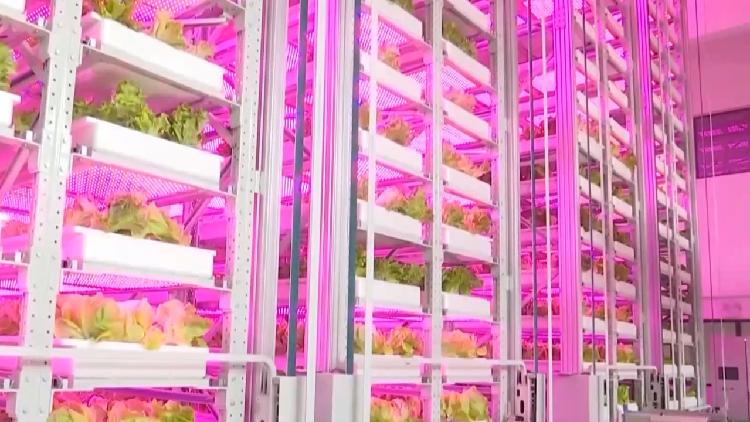Can’t be the first cause I did this in Minecraft years ago
I’m always suspicious of these tech farms because it costs a lot of electricity to run those LEDs to produce the amount of energy needed for food.
In America, these would just be used to make more corn that would be used to create biofuels that would be used to run the generators that would be used to run the LEDs. The whole goddamn thing would run at a loss, but a lot of people would make a lot of money in the meantime.
Oops got mad at capitalism again haha.
Anyway…
It does seem like they’re doing it the right way. Producing foods that they can’t normally produce year-round or producing foods that They can’t produce much of normally.
They also talked about using it for starter plants which is a good idea. And I’m sure experiments are much better in a consistent environment like that.
Woop woop!
I’m surprised fiberoptics isn’t used more for this stuff. This sort of stuff seems like an obvious thing to do https://www.energysage.com/solar/solar-accessories/solar-fiber-optic-lighting-overview/
From what I’ve seen, the electric cost is actually only a small component, the building, specialized hardware, maintenance and labour make up the majority of the bill for most vertical farming operations.
Further, it’s a matter of how much energy density you need within a given volume compared to the available roof surface. Most plants don’t need full sun, but you might only be able to supply 2-4 times the roof area as internal grow area (when accounting for efficiency losses and the needs of the plants). You would need to provide the majority of the grow area with LED lights anyway. So it might not be worth the resources/labour costs. Though it might be a good supplemental supply of photons.
The only real use case I can see for vertical farming is providing fresh produce nearer to urban centres, or if there is an acute shortage of land, otherwise passive greenhouses (with supplemental lighting and heating if needed) are generally a better use of resources. Specialized produce is another use case, but it seems that we need a lot more research to make it a viable option at scale.A question of where the energy comes from is also important, solar panels in a desert/on roof tops is good, but if they replace a farm field it’s pointless. Wind, nuclear, hydro are good options.
I’m definitely curious to see how the field grows within the context of China and socialism more broadly. Many of the constraints in current implementations are only important when the only consideration is profit.
Edit: read the article, they have some really interesting use cases in their facility beyond what I could imagine.
It’s good point about the amount of sunlight available via the roof being limited. The main value I see comes from having a controlled environment. I guess it doesn’t really need to be vertical, but the key part is that you can regulate temperature, humidity, and so on. And yeah, I think this sort of stuff becomes much more interesting when the profit motive isn’t the primary goal. I imagine China is investing into this as a way to ensure stable food supply for the people as the primary goal.
It’d be neat if they could manage to grow new crops with it. The technology has plateaued in the west to the point that my university, which leads a lot of research in the field, has students flooding out of the concentration because there’s no job market anymore. The kind of horticultural background you need is very specialised and the only other thing you can do with it is cannabis cultivation.
AI used for something productive once? Shocking.

This is why it’s a good thing that China doesn’t just chase profit like we do in the west. The main value I see in vertical farming is having controlled climate. As the climate crisis deepens we’re going to see more and more extreme climate events like droughts and heatwaves happening. This has potential to kill harvests and cause famines. In fact, crop failures are already starting to be a problem in North America. Building indoor farms is the best way to ensure food supply stability going forward in my opinion.
Vertical farming is believed to be the future of agriculture because it allows people to grow crops in upright trays and save precious land space for other human activities.
uhhh this sentence is wrong but yea
the least damaging “human activity” on land would be some type of traditional farming, the only thing “less damaging” than that would be letting it return to wilderness, which is not a human activityTo be fair, if we did confine farming to sckyscrapers we could use the vast amounts of land traditional farming occupies for parks, nature restoration, and so on. And China has been doing most in terms of rewilding globally, so there is that.
okay but the only thing you’d be able to grow is lettuce and herbs. It’s nice saving the amount of space those take up I suppose, but it’s not a farming revolution either
That’s not true, China is already growing a range of foods using indoor farms. The article mentions soybeans being grown in these farms, and and mushrooms are another example https://www.scmp.com/video/china/3158837/chinese-mushrooms-grown-smart-greenhouses-spur-multimillion-dollar-business
I would be highly skeptical of these farms, these are incapable of growing crops with actual density like tubers, beans, grains, etc… There is a reason you only see them growing leaf vegetables or mushrooms, and these end up tasteless due the lack of nutrients.
One of the problems i see with this way of farming is that it ignores that crops are connected to nature, crops do not grow in a vacuum. The soil is an ecosystem in which a huge array of microorganisms interact with each other, stuff gets decomposed by microorganisms, microorganisms leave residues, plants absorb these residues, plant leaves residues, and so on… When farmers harvest their crops, a huge portion of matter is taken away from this ecosystem (because you literally export the grain out of the soil), in order to keep building the soil organic matter farmers need to incorporate the crop residues into the soil AND add external inputs to keep building up the soil. It is a process, in which each harvest farmers have to provide the nutrients depleted by the exported harvest AND, in order to produce more, keep adding to it. But as you can see, most of the heavy lifting is done by the microorganisms that live in the soil, this is the big reason why i don’t think these vertical farms will ever be as efficient as regular farms. ( do these farms have to literally provide every single nutrient manually?, doesnt seem very efficient to me)
Also can’t convince me that providing light electronically is more efficient than literally using the sun energy lmao.
One aspect to keep in mind is extreme weather due to climate change. Indoor farming provides a controlled environment, which helps ensure a stable food supply. I think questions like efficiency are secondary in face of that. If you have a heatwave that kills all the crops then you get a famine, and that’s the risk that needs to be mitigated going forward.
That said, I don’t think you necessarily need to have vertical farms. Maybe simply creating giant greenhouses where you can keep a stable temperature on regular soil it good enough. But this is absolutely something that needs to be explored actively given where we’re headed.








